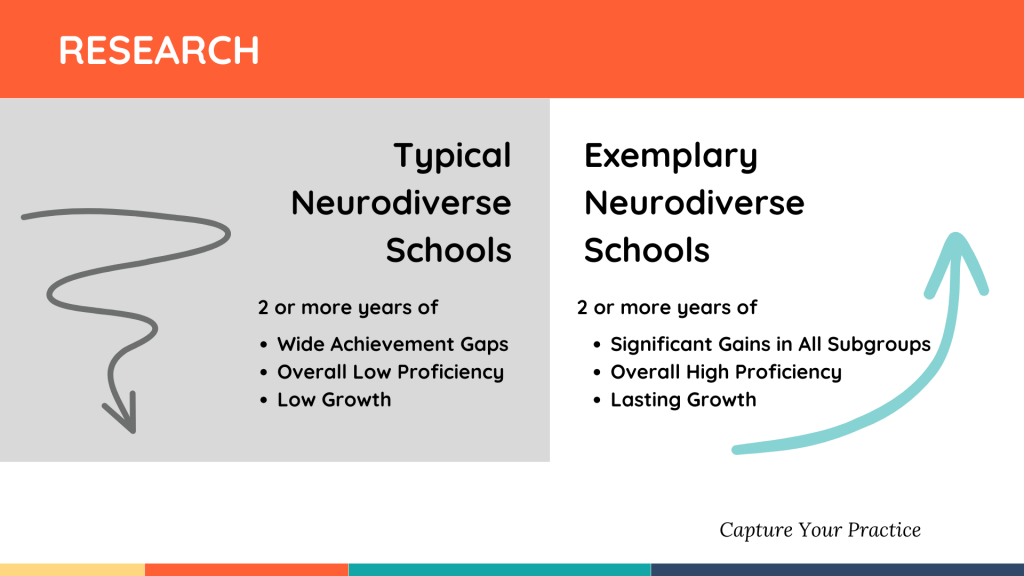The way you think causes problems you can’t solve because of the way you think.
When people in schools think about data, do they think about early warning signs? Unfortunately, the tests they think about most are the tests that are not very useable for solving their problems. The state test results from the prior year come back when the year is over. Diagnostic tests are not given frequently enough to turn the tide. So what do exemplary schools use to determine their progress? In this post you will learn about early warning signs and how to take the next step from typical to exemplary.
What are the Early Warning Signs?
Typical schools with diverse populations experience a kind of a doom loop. Does your school’s data look like this? If so, you are not alone. Why are so many schools experiencing this performance? More importantly, what data do exemplary schools use to give them what we call “go upness”?
Remember that typical schools have an official versus a taught curriculum and that a standards based pacing guide is the first vital data source for changing that. The next vital data source is assessment. Typical schools use below grade level assessments, while exemplary schools assess on grade level or higher from day one.
As a leader, do you struggle with analyzing data? Do you wonder if it is really helping to solve the problems you think you have? Do you ever wonder if there is something you are missing? If you answered to any of these questions, read on!
Data is sometimes the devil.
What is data?
What is data? Data is actually every piece of observable information in your environment. It’s a huge pool of records, lessons, assessments, and meeting notes, it also includes students’ responses, conversations, facial expressions, what’s in the halls and on the walls. Your data pool is everything observable. It is not humanly possible to know and evaluate all of it, so you have to select what to focus on. That selection determines just about everything that happens from there. What do I mean?

A Helpful Graphic
There is a helpful graphic called The Ladder of Inference. It was created by Chris Argyris and Peter Senge to describe the thought process that we go through, to get from an observable fact to a decision or action, usually without even realizing it.
The first data we select in typical school is last year’s state test and the new diagnostic screener data. This is usually the first early warning sign. The meaning they ascribe to it is “Wow. These kids are low.” They assume that the people in the prior grade level (or levels!) did not do the job.
So, how do they act on this early warning sign? Typical schools conclude that they will have to reteach much of the prior grade standards, if not farther back than that. This leads them to believe almost from the get go that the students are so far behind that they will never meet the standard expectations. Then they act upon those beliefs with even lower level tasks and tests. In the end, the next grade level can say the same thing about them one year later. The ladder of inference shows how the very data that is supposed to help us solve problems, turns out to the devil that keeps us where we are.
How to Heed Early Warnings
Get Real
The answer for typical schools when faced with early warning signs like being off pace is to dumb down the tests. This leads everyone, especially students and families, to a false sense of security about performance. They delay the inevitable at least until the midyear diagnostic or to sometime in March when everyone starts to panic. If you think March Madness is about basketball, you probably don’t work in a school. The worst surprise in education is an A student who fails the state test.
Back Down the Ladder
You are tasked to transform this typical culture, but you are given little advice on concrete steps to take. Cultures evolve. They evolve through action taken at the top of the ladder of inference. The first purposeful action you can take to change your culture for the better is to select data sources that change what people talk about. In turn, the new talk changes how they practice, which, then again, changes the culture and the culture is was changes the shared image of good teaching. In other words, by reverse engineering the ladder, you can change the trajectory of the loop. The reason students are behind is they never accessed the grade level curriculum. Typical schools complain about it. Exemplary schools address it by acting on the early warning signs from day one.
Change the Talk
When you align assessments to a standards based pacing guide talk shifts immediately from “What should we do this week?” to “Where are we now in the big picture?” This prompts problem solving in a new direction. So, school leaders should check lesson plans weekly to be sure they are on the pacing guide. Then, they should visit classrooms and gather data about who is on pace and teaching the lesson they submitted. Then, you can start analyzing assessments that are aligned to the work you saw done.
Exemplary schools use systems that demand accountability for staying on pace by assessing on level. They don’t problem solve by compromising on rigorous assessments that match the state test. They change the conversation instead.
For instance, they ask things like, What have our students mastered? What have they missed? Why did they miss it? Did we teach it? Did we misunderstand this standard? What can we do while we still have time? Here’s what’s great. Exemplary school only experience march madness in basketball. Why not? Because they know where the problem is on the second or third week of school and every few weeks forward for the entire school year. They give themselves time to problem solve and innovate every step of the way.
The Rewards of Heeding Early Warning Signs
By paying attention to the early warning signs like staying on pace and demanding accountability in assessment, you can proactively manage teacher stress. Then, you are much more likely to keep the people you want. If you are fearless about addressing the early warning signs and telling the truth about where your students are at every time of the year, you can determine how to engage them in more efficient, productive and interesting ways well before it’s too late.





